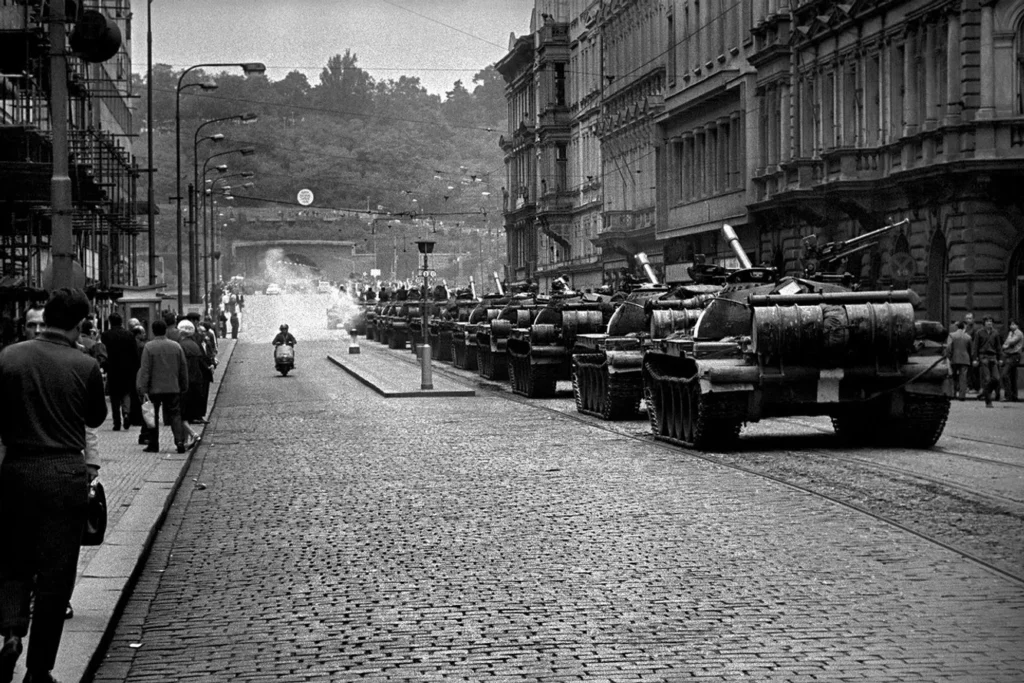
On August 21, 1968, the streets of Prague, Czechoslovakia, were engulfed in turmoil. Tanks from the Warsaw Pact rolled through the city, crushing the spirit of the Prague Spring and signaling a brutal end to a period of political liberalization and optimism. Amidst this chaos, a young theater photographer named Josef Koudelka found himself thrust into the role of a photojournalist, capturing some of the most powerful and evocative images of the invasion.
Koudelka had never been involved in journalism before. His world was one of stage lights and actors, not soldiers and protests. But the events of that fateful day changed everything. With a keen eye for drama and a natural instinct for storytelling, Koudelka documented the raw emotions and defiance of the Czech people as they faced the overwhelming force of the Soviet military.
One of his most iconic photographs from this period shows a lone man standing atop a tank, defiantly waving a flag amidst the smoke and destruction. This image, part of the series later known as “Invasion 68 Prague,” encapsulates the spirit of resistance and the tragic reality of the occupation. It is a testament to the power of photography to capture history in a single frame.

The journey of these photographs to the wider world was as dramatic as the events they depicted. Smuggled out of Czechoslovakia, they reached the hands of Magnum Photos, a prestigious photo agency. To protect Koudelka and his family from potential repercussions by the oppressive regime, the agency credited the work to an anonymous “Prague photographer.” It wasn’t until many years later that Koudelka could safely claim authorship of his extraordinary work.
In 1969, these haunting images were published in The Sunday Times, bringing global attention to the plight of the Czech people and the brutal suppression of the Prague Spring. The power and authenticity of Koudelka’s photos earned him the Robert Capa Gold Medal, a prestigious award given for exceptional courage and enterprise in photojournalism.
Following the publication of his work, Koudelka was advised by Magnum Photos to leave Czechoslovakia. He emigrated to the United Kingdom, where he was granted political asylum. For over a decade, he continued to document life and culture, but it wasn’t until 1984, 16 years after the invasion, that he
This story was inspired by “The 100 Photographs That Changed the World”
“The 100 Photographs That Changed the World,” edited by Roberto Mottadelli, Margherita Giacosa, and Gianni Morelli, is a compelling exploration of significant historical moments captured through the lens of photography. Published on March 7, 2017, this book showcases 100 images that have profoundly impacted our understanding of world events and social changes. From the opening of King Tutankhamun’s tomb to the Wright Brothers’ first flight, from the atomic bomb mushroom cloud in Nagasaki to the first moon landing, each photograph in this collection represents a pivotal moment in history. These images not only document important events but also highlight the power of photography to influence public opinion and raise awareness about critical issues.
The book includes detailed commentary on each photograph, providing context and insights into the events and the photographers behind these iconic images. This expertly curated collection spans various themes and periods, making it a rich resource for anyone interested in the intersection of photography and history. Margherita Giacosa, a freelance editor with a background in the history of art, Roberto Mottadelli, an art historian and managing editor, and Gianni Morelli, a writer with a focus on history and geography, bring their diverse expertise to this project. Their collaborative effort ensures that each photograph is not only visually striking but also historically significant, offering readers a comprehensive understanding of the moments that shaped our world.













